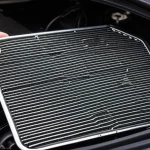Essential tools and preparations for installing crash bars on your Kawasaki Versys 300
Getting ready to protect your ride
When tackling crash bars installation tools for your Kawasaki Versys 300, having the right equipment simplifies the job and ensures safety. Start by assembling basic hand tools: a set of metric wrenches and Allen keys is crucial, with sizes typically including 8mm, 10mm, and 12mm. A torque wrench is highly recommended for tightening bolts to manufacturer specifications—this prevents over-tightening, which can damage threads or compromise the bars’ stability.
Also to see : Unlock the potential of your kawasaki kz1000: ultimate carburetor cleaning and tuning handbook for peak performance
Setting up a clean, flat workspace is another key part of Kawasaki Versys 300 preparation. A well-lit garage or a sturdy workbench allows better control. Lay down protective mats to avoid scratching your bike’s finish during installation. Personal safety is vital; wear gloves and eye protection to guard against injuries from sharp parts or flying debris.
Before beginning, thoroughly review the installation kit for missing parts. The kit usually includes crash bars, mounting brackets, bolts, washers, and instructions. Confirm every component is present and undamaged to avoid mid-installation interruptions. Missing any bolts can derail the process and risk improper fitting, so double-checking upfront saves frustration. This is especially important for those engaging in beginner motorcycle maintenance, ensuring a smooth, confident project start.
Also to read : Unlock the perfect fit: ultimate guide to moto guzzi v9 bobber engine bolt torque specifications
Understanding your Kawasaki Versys 300 crash bars: Compatibility and design
Ensuring the perfect fit and optimal protection
When selecting Kawasaki Versys 300 crash bars, compatibility is critical. These bars must integrate seamlessly with the bike’s frame to provide reliable protection without affecting handling. crash bar compatibility depends on the exact model year and any aftermarket modifications, so verifying your bike’s specifications is essential.
Crash bars come in various designs—primarily tubular steel or aluminum—and each offers a balance of strength and weight. Tubular steel bars are robust, ideal for absorbing impacts, while lighter aluminum options may enhance maneuverability. Understanding which type best suits your riding style and protection needs helps in making an informed choice.
Assessing crash bar fit includes checking for precise mounting points and ensuring all hardware—bolts, brackets, and spacers—is included. Missing or ill-fitting hardware compromises the bar’s stability and effectiveness.
The importance of correct crash bar alignment cannot be overstated. Misaligned bars might fail during a fall or create additional stress points on the frame. Always use manufacturer guidelines or expert installation to secure proper alignment, guaranteeing that your motorcycle protection accessories perform as intended.
Step-by-step crash bar installation process
Ensuring safety and style with your Kawasaki Versys 300
Start by carefully removing existing panels that may obstruct access to the frame where crash bars mount. Use appropriate tools like screwdrivers or Allen keys to avoid damaging fairings or fasteners. Cleaning the frame area ensures a solid connection and prevents corrosion over time.
Next, align the crash bars to the designated mounting points on the Kawasaki Versys 300 frame. It’s crucial to confirm that the bars fit flush without forcing, as misalignment can affect both protection and aesthetics. Some kits provide spacers or brackets; use them as instructed to achieve perfect positioning.
Finally, secure the crash bars using the bolts included in the kit. Follow the torque specifications carefully—overtightening risks stripping threads, while undertightening may lead to instability during impact. Using a torque wrench guarantees precision. After installation, inspect all mounting points, and double-check that the crash bars do not interfere with controls or exhaust components. This DIY approach balances durability with rider safety, allowing you to enhance your Kawasaki Versys 300 confidently and effectively.
Safety precautions and common installation pitfalls
When installing a crash bar, prioritising safety ensures your motorcycle is protected without compromising its structure. One major concern is preventing damage to the frame and fairings. Avoid overtightening bolts, as this may warp the frame or crack delicate fairings. Use torque settings recommended by the manufacturer to maintain integrity.
Recognising and avoiding common errors during installation is crucial. A frequent mistake is misaligning the crash bar, which reduces effectiveness and may cause interference with controls or steering. Double-check fitment by loosely fitting all components first, then systematically tightening them. This approach reduces the risk of stress points and misplacement.
Before every ride, perform safety checks, including verifying all bolts are secure, and the crash bar is firmly attached without movement. Examine areas around mounting points for any signs of cracks or undue pressure. Testing steering motion with the crash bar installed ensures it does not restrict control. Adhering to these motorcycle DIY tips and precautions prevents costly mistakes and enhances rider confidence.
Troubleshooting and fine-tuning crash bar installation
Proper crash bar troubleshooting starts by carefully inspecting areas prone to vibration or rattling after installation. If you notice any unusual noise, first check that all bolts are tightened according to specifications. Loose fasteners often cause rattling in Kawasaki Versys 300 install problems. Use a torque wrench to ensure each bolt reaches the recommended torque, preventing further looseness during rides.
Adjusting crash bars involves fine-tuning their position for optimal clearance and alignment. Misaligned crash bars can interfere with the bike’s frame or accessories, so double-check measurements against the installation guide. Slight shifts in positioning can alleviate clearance issues without compromising protection.
Regarding re-torquing, it’s essential to revisit all mounting bolts after your first ride. Heat cycles and vibrations can cause fasteners to loosen initially. Use the correct torque settings specific to the Kawasaki Versys 300 install problems to maintain structural integrity and safety. This proactive step addresses common crash bar troubleshooting concerns before they evolve into bigger issues.
Additional resources and visual guides for crash bar installation
Finding the right crash bar installation video is crucial for a smooth and confident DIY project on your Kawasaki Versys 300. When selecting Kawasaki Versys 300 tutorials, prioritize those created by experienced riders or professionals who focus specifically on your model. These videos often provide step-by-step guidance that matches the unique framework and mounting points of the bike.
Visual aids like detailed diagrams can greatly simplify the process. Clear illustrations help clarify how crash bars align and attach, highlighting bolt positions and necessary tools. Such diagrams prevent guesswork and reduce the risk of improper installation.
For those seeking further support, official Kawasaki manuals and motorcycle DIY resources offer in-depth technical specifications. Forums and enthusiast groups centered on the Versys 300 also serve as valuable hubs where users share tips, troubleshooting advice, and personal experience. Exploring these resources ensures you’re not alone and helps build practical knowledge tailored to your crash bar installation needs.


